Seeing Red
The Council for British Archaeology has joined forces with the Seeing Red campaign to adapt and promote their incredibly successful guide for use within volunteer community archaeology, history and heritage groups.

What is Seeing Red?
Seeing Red is a campaign to improve the provision of menstrual hygiene and welfare facilities on archaeological sites. The campaign to date has mainly focussed on the commercial archaeology sector and the messaging has been geared towards commercial organisations of all sizes, supporting both employers and employees.
The campaign offers written guidance and background to the issues, alongside access to a free menstrual hygiene and welfare pack (based on availability). Amazing!
What is the CBA involvement?
The CBA approached the Seeing Red team to offer support to adapt and promote the guide for volunteer community archaeology, history, and heritage groups. The CBA will also be working with Seeing Red later in the year to develop guidance for youth clubs, including the YAC.
The funding for this project has been made available through the Karen Gavin Archaeologist Memorial Fund. Karen was a community archaeologist and felt very strongly about this issue. After discussing various projects with her husband, Tony, he decided to put his full support behind this campaign.
At the Festival of Archaeology 2021, the founder of Seeing Red, Amy Talbot gave a talk about what the campaign is, why it is necessary and what volunteer community groups can do to provide improved menstrual hygiene and welfare facilities during archaeological fieldwork. You can now watch a video of this talk on YouTube.
Who is behind the Seeing Red Campaign?
Amy Talbot is a Heritage Consultant within the renewable energy sector. In 2018 she and three colleagues from the CBA-YAC Pontefract Club formed the Mentoring for Women* (inclusive) in Archaeology and Heritage (MWAH) organisation which currently has over 1700+ members across the world who all work in archaeology and heritage related disciplines.
In 2019 she created the Seeing Red menstrual hygiene movement in archaeology, after 7 years of poor hygiene facilities on sites and being unable to safely menstruate. MWAH provided the launchpad for Seeing Red as it was only through asking the group if anyone else was struggling, that the horror stories of poor menstrual facilities across most commercial, academic, and community groups came out. Seeing Red was officially launched in 2019 and successfully began in 2020. Despite the pandemic, Seeing Red has been supported by, Prospect Archaeologists Union, AshTree Heritage, and British Archaeological Jobs and Resources (BAJR) in creating a free downloadable BAJR guide for commercial archaeological units to use in supporting their menstruating staff. As well as by the Federation of Archaeological Managers and Employers (FAME) to encourage better menstrual hygiene and welfare across commercial archaeology sites, using on-site hygiene packs.
As of 2021, every FAME registered organisation has received a free menstrual hygiene and welfare pack from Seeing Red, with countless more sent out to staff and individuals across the commercial archaeological sector.
The Power of Archaeology
The Power of Archaeology campaign aims to get MPs and local Councillors more closely engaged with archaeology and heritage issues, raise the profile of threats posed by cuts and planning policy reform, and make sure that decision-makers understand what archaeology does for us all and why people care passionately about it.
This page will give you information on how to get involved and support the campaign and its aims. The following downloads provide further advice on what you can do:
A greater range of advice toolkits can be found here.
Why archaeology needs you!
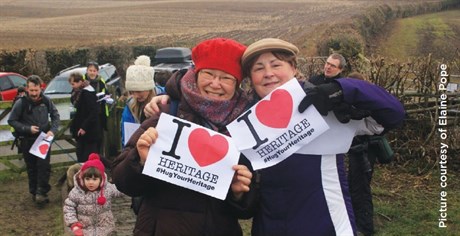
We want to get people talking about archaeology in the corridors of government. We want every MP and every local Councillor to hear from constituents and ward residents about the fantastic work that archaeology does in communities - from the amateur history and archaeology groups working to discover information about the local past and engage communities, to the professionals who maintain historic environment records, facilitate good planning, and check inappropriate development.
We need your help to do this! Whether by writing, meeting, or tweeting your MP, attending an event, or sending us a statement of why archaeology is important to you and why government support for archaeology (whether local authority services, museums, or sympathetic policy) is vital.
MPs often talk about their 'local heritage' and refer to local famous monuments, such as castles or stately homes. They also talk about local industry, culture and identity. However, they are often unaware of how much archaeology and heritage there is around them, how it links people and places together through time, and how much it matters to people.
Your MP has a responsibility to listen to your concerns about your local heritage, and you have a right to ask for a response to issues that matter to you.
Demonstrating the direct power of archaeology through the actions of local communities enables us to work more effectively towards these ends.
Archaeology Matters!
Archaeology creates real benefits for people and places, the economy, and culture and society. Whether through enhancing tourism opportunities, creating local distinctiveness and brand, or simply by promoting community cohesion, cultural awareness, or individual social benefits.
There are an estimated 200,000 volunteers engaged in archaeology in England alone, contributing an estimated 20 million volunteer hours per year. A conservative estimate of the net worth of this contribution puts it at nearly £175 million. This figure represents archaeology that generates a wide variety of outputs and outcomes - from producing significant archaeological research and making new discoveries, to managing our network of Young Archaeologists Clubs, to providing guided tours, managing local archaeological sites and putting on exhibits or just helping out at local museums!
We want politicians to understand that archaeology is all around us - from mountain top to sea bed! There are more than 1.4 million records of archaeological sites in the UK - that's an average of 10 per square kilometre! 95% of people think it is important that heritage places are looked after, and 74% believe that the government has a moral obligation to protect heritage sites.
Furthermore, archaeology is enjoyed by millions of people each year, both tourists and locals. It is one of the most recognised aspects of the UK's heritage, a key element of our tourist offer, an educational resource for our children, and a backdrop to our daily lives!
Current heritage concerns in parliament
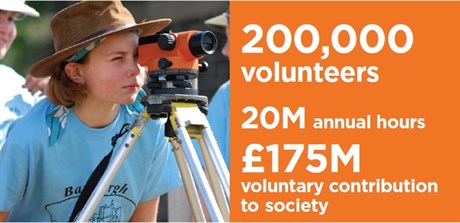
The Neighbourhood Planning and Infrastructure Bill and Housing and Planning Act are examples where current government reforms have illustrated the lack of wider understanding of the role that archaeology currently holds in the planning system and how prevailing political priorities can impact them if there is not a strong voice raised in opposition.
Furthermore, cuts to local government are leading to archaeology services being eroded to the point of collapse, and in some areas, where councils have been especially affected by the reductions to their budgets, have been cut entirely. In many places, specialists are struggling to maintain databases of information on the historic environment (known as Historic Environment Records) and can no longer effectively advise on applications for planning permission in order to minimise impacts on heritage assets and maximise public benefit.
What can you do?
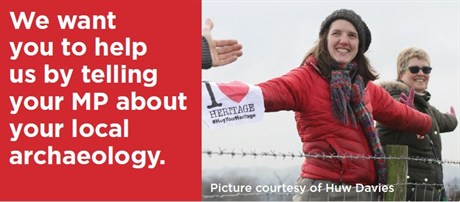
Here's a list of things you might be able to do:
- Fill in an Archaeology Matters Pledge Card and send it to your local MP or Councillors
- Write to your MP to tell them about local heritage events you are attending, and ask whether they'll be going
- Write to your local councillors and ask how they will be contributing to the Festival of Archaeology
- Tell us when you have written to them and when you have received a response, so we can log details - you can contact us at [email protected]
- Use social media to send pictures of your event or your visit to an archaeological site. You can also find and contact your MP on Twitter through a postcode search here
- Contact the CBA for further advice!
Archaeology Matters Pledge
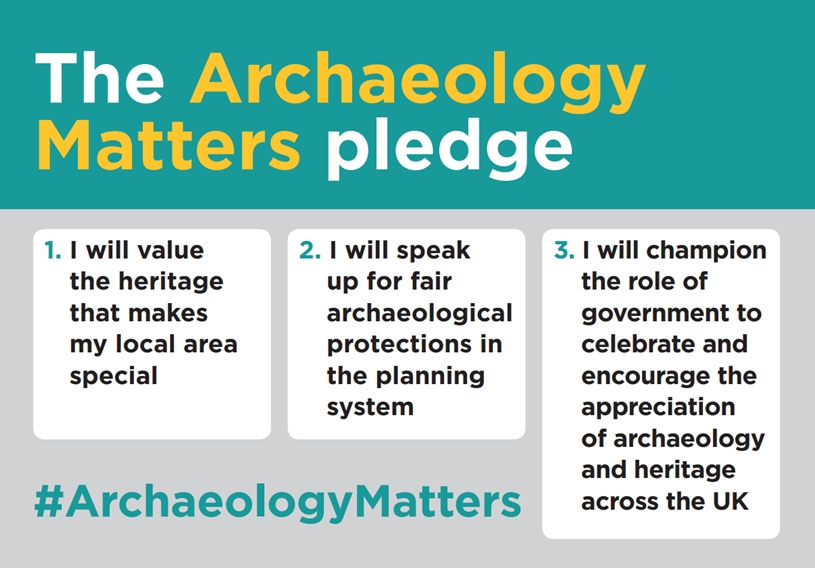
Fill in your pledge cards now!
- Download as many cards as you need
- Distribute to your group members, colleagues, or friends who care about heritage
- Fill in the cards with a personal message
- Send them to your local MP or Councillors
- Let us know who you've contacted and if they respond!
As part of the ongoing Power of Archaeology campaign, we've produced pledge cards for our supporters to use and distribute. The cards are designed to be filled in by you with a personal message relating to why you care about archaeology and heritage, and then invite your MP/Councillor to respond to 'sign the pledge'.
Filling in the card is an easy way to share a personalised message with your parliamentary or local council representative. It can include anything relevant you want to add, but we have shared some tips below.
Anyone can fill these cards in, whether you are a professional who works in heritage or archaeology, a local group member, or simply an interested individual. You can mention a specific site or simply express general care for the past - all that matters is you show them that people care.
You can download the card to print at home using the link below. Alternatively, if you would like us to post you a pack of postcards please email us at [email protected].
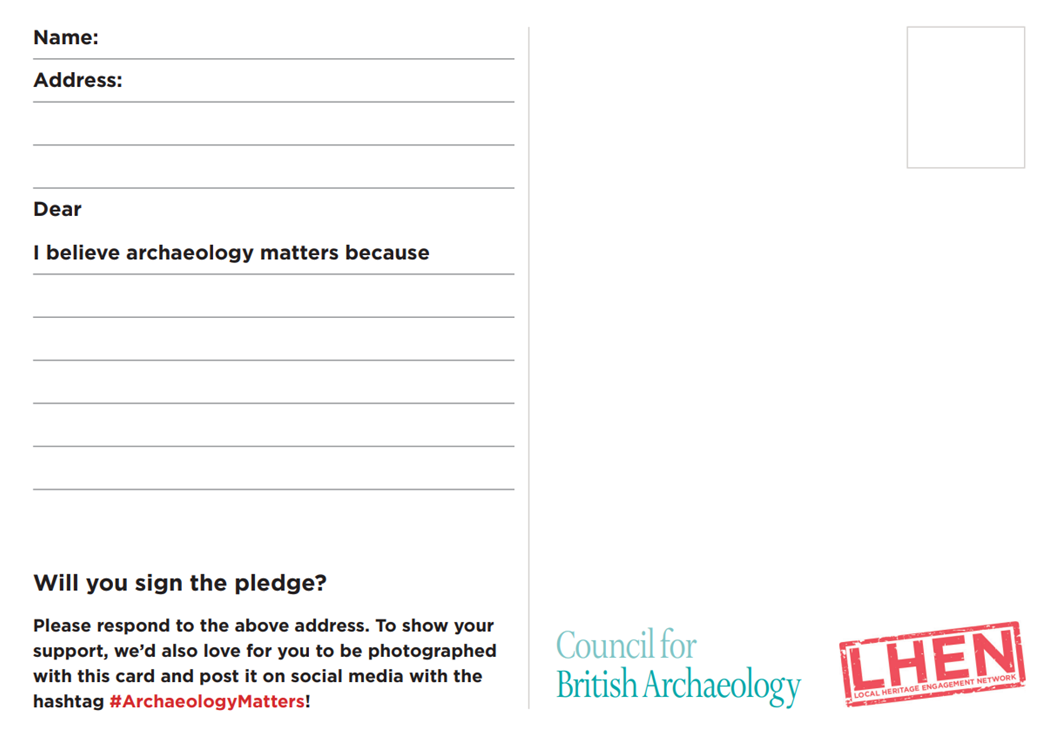
Tips:
- Include your name and address: This is vital to ensure that your message is read as MPs require evidence you live in the constituency/ward they represent. It is also needed so they can respond to you!
- Include personal or local information in your message: A personal message is more likely to be impactful than something general.
- Want to say more? Do it! Staple the card to a letter: The postcard does not have to stand alone, and may in fact be more useful as an ice-breaker for a real discussion about local heritage!
- Include questions or 'asks': For example 'can you show your support for X site or building in X town'?
- Follow up: It can take a few weeks to get a response from your MP, but it is important that you follow up whether they respond or not. Sharing the Pledge card (or a photo of your card) on social media can be a great way to add a little bit of public 'performance' and some weight to your request!
Stonehenge
The Council for British Archaeology has taken a long-standing interest in the presentation and long-term preservation of the Stonehenge World Heritage Site – a unique cultural landscape.
The CBA broadly supports the position of ICOMOS UK which seeks to “achieve a solution which respects and maintains the Outstanding Universal Value of this iconic, important and unique site at the earliest opportunity”.
Listed below are some of the CBA's most important interactions with Stonehenge and the surrounding debate.
More coming soon...
2018
CBA produces a special edition of British Archaeology highlighting the latest discoveries at Stonehenge to inform the tunnel debate. Available for download here. The Stonehenge special report got coverage in the media, with several major news outlets featuring stories from it, including the Times, The Daily Mail, and Radio 5 Live. One aspect of our report that really caught people’s attention was our editor’s insight that Stonehenge may have evolved over a far longer period than previously considered, and that its position and importance may have derived from natural stone formations, which were there long before humans themselves.
2017
Archaeologists excavated the West Kennet enclosures (surviving as deep, narrow trenches dug to hold oak palisades) between 1987 and 1992. Finds from the dig have been re-investigated in a Historic England-funded project, with sensational results.
Originally thought to be contemporary with Avebury’s megaliths and Stonehenge, the enclosures have now been revealed to be up to 1,000 years older, and date to around 3300BC.
The new study has also shown that centuries after the enclosures had burnt to the ground, the site became a large settlement where the people who built nearby Silbury Hill lived.
These conclusions follow a major radiocarbon dating programme using samples from the old excavations.
After re-investigations of archaeological finds, details of the new research and a broader history of Avebury are available in the latest edition of British Archaeology magazine.
2016
In early 2016, CBA trustees revisited earlier documents that had previously informed the CBA's engagement with Stonehenge, and in April agreed on a revised and updated set of Cardinal Principles which the CBA believes are crucial in considering the management of the monument and its surrounding landscape. They will be particularly important in relation to any proposal for the A303 within the World Heritage Site which might be published for consultation in 2017.
The revised Principles were made available to all CBA members as a consultation draft in the summer of 2016, and trustees considered all responses at their meeting in October. The final draft of the updated Principles was then circulated to members for discussion and adoption at the 2016 AGM in November.
The final updated document, as approved by CBA members at the AGM, is available for download below.
![]() CBA statement on Stonehenge 2016
CBA statement on Stonehenge 2016
2015
Stonehenge-related presentations and discussions at the CBA 2015 AGM.
2013
As part of English Heritage’s project to transform the setting and visitor experience of Stonehenge, a section of the A344 road running right past the monument, almost touching the Heel Stone, was permanently closed. The new Stonehenge visitor centre, located 1.5 miles away from Stonehenge, open in December 2013.
2010
The CBA responds to Wiltshire County Council’s consultation on the proposed Traffic Regulation Order to close the A344 to motorised traffic in the vicinity of Stonehenge.
2009
January: CBA writes to the Minister for Culture, Creative Industries and Tourism, Barbara Follett MP, about the options for the new visitor centre at Stonehenge.
May: DCMS announced its decision to develop new visitor facilities at Airman’s Corner; 2.5km (1.5 miles) west of the current visitor centre at the edge of the World Heritage Site, and with good access to the Stones.
October: English Heritage unveiled its design for the proposed visitor centre for Stonehenge, submitting a planning application to Wiltshire Council along with an application to close the A344 that runs adjacent to the Stones.
CBA Director Dr Mike Heyworth MBE said of the decision:‘‘The CBA welcomes this decision as part of a sustainable 21st-century solution to the dual challenges of improving visitor access and conservation for this outstandingly important World Heritage Site. We applaud the Government’s support, and the commitment of the project’s partners, in taking the first step towards creating the public facilities and environmental improvement that Stonehenge’s world-class archaeological landscape deserves. The scheme will include an efficient, all-weather visitor transit system, offering visitors the convenience of being dropped off near the monument. It is envisaged the new site will enable increased educational and interpretation facilities."
November: The CBA comments on the planning application for a new visitor centre and related works in the Stonehenge World Heritage Site.
2008
October: CBA responds to the ‘Future of Stonehenge’ consultation on options for Environmental Improvements and the Management Plan Review for the World Heritage Site.
July: English Heritage announces a public consultation on ‘The Future of Stonehenge’, seeking views on the review of the Stonehenge World Heritage Site Management Plan and English Heritage’s short-listed options for new visitor facilities. The background and options are discussed in British Archaeology (issue 102).
2006
January: The Highways Agency announces a public consultation on five alternative options for the A303 Stonehenge Road Improvement Scheme. The CBA and other bodies issue a press statement expressing their disappointment with the limited scope of the options and failure to engage the National Trust in the review process.
March: Independent conservation organisations, including the CBA, National Trust, ICOMOS-UK, The Prehistoric Society, Rescue and the Wiltshire Archaeological and Natural History Society, issue a joint press release with a collective response expressing their common view on the consultation options. English Heritage re-submits its planning application for a new Visitor Centre at Stonehenge.
April: The CBA makes its response to the Highways Agency consultation.
2005
July: The Minister for Transport announces the outcome of the A303 Stonehenge Improvement Public Inquiry. The Inspector’s report is satisfied with the Published Scheme for a short (2.1km) bored tunnel, opposed by the CBA and others at the public inquiry.
August: ICOMOS-UK, the CBA, the National Trust and others issue press statements and write to Ministers urging that the opportunity be taken to set the terms of reference of the review as widely as possible and to include key stakeholders in the process.
2004
February: Public inquiry into the proposal to improve the A303 at Stonehenge. The inquiry will open on Tuesday 17 February 2004 at the Guildhall, Market Place, Salisbury, Wiltshire SP1 1JH, and will continue, from 18 February, at the main inquiry venue - Cross Keys House, Salisbury. The CBA submits its evidence. Daily transcripts of the inquiry are available.
May: The roads inquiry ends. The CBA submits a closing statement summarising its case.
2003
September: Council for British Archaeology Lodges Formal Objection to A303 Trunk Road (Stonehenge Improvement) Draft Orders. A statement of the CBA’s case is circulated to all CBA members for comment.
2002
February: The CBA hosts a meeting about the roads proposals for Stonehenge and their integration with other changes to the World Heritage Site.
November: The CBA releases a provisional position statement on the Stonehenge A303 tunnel options.
1993
Department of Transport consults on alternative routes to improve A303 between Amesbury and Berwick Down. In the vicinity of Stonehenge, two options are put forward: Grey, swinging to the south, and Yellow, involving on-line upgrading. The CBA argues both options to be unacceptable in the context of a World Heritage Site. DfT subsequently finds the results of this consultation ‘inconclusive’.
1998
The CBA’s Annual General Meeting endorses a memorandum that identifies principles and criteria to assist the formulation of a strategy worthy of Stonehenge, and furnishes the Council with a view on the Government’s emerging proposals.
Reuse, Don’t Replace!
What’s the Problem?
Whilst listed buildings are protected within the planning system, not everything that we value about our places is officially recognised or designated. Lots of local planning authorities maintain a ‘local list’ of places that matter to local people, but don’t meet the criteria for statutory designation.
However, when push comes to shove in the planning system, being locally listed often offers little or no protection from demolition when an old building is in the way of a new development scheme. Demolition is still often accepted over the reuse of our historic building stock with excuses usually boiling down to cost and an outdated mindset that old buildings are ‘inefficient’.
The greenest building is the one that already exists
Key Words
Embodied Carbon – Carbon dioxide equivalent (CO2e) or greenhouse gas (GHG) emissions associated with the non-operational phase of a building such as, resource extraction, manufacture, transportation, assembly, maintenance, replacement, deconstruction, and disposal.
Operational Carbon - Carbon dioxide equivalent (CO2e) or greenhouse gas (GHG) emissions associated with the usage and lifespan of a building such as lighting and heating.
Whole Life Carbon – Sum of both the Embodied and Operational carbon dioxide equivalent (CO2e) or greenhouse gas (GHG) emissions.
Adaptive reuse – Renovating and adapting an existing building (usually historic) to suite a new purpose.
Retrofitting – Adding a component to a building after its construction usually to upgrade energy performance and efficiency (especially in old buildings).
